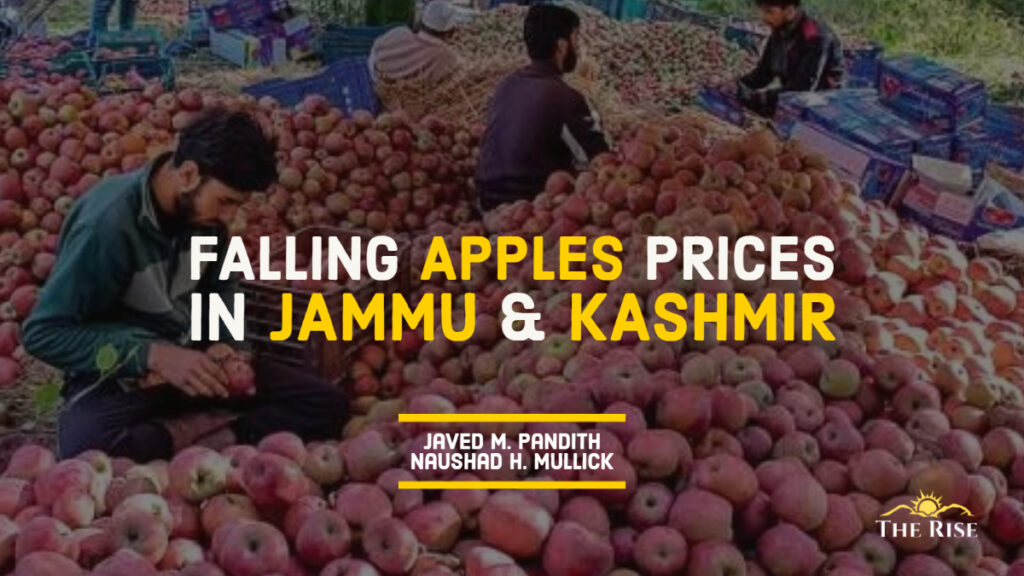Apple growers in Kashmir Valley are on the roads to express their simmering anger due to price crashes and infrastructural bottlenecks. Out of 2.1- 2.9 million tons of apples grown in India annually, around 75 percent comes from the Kashmir valley. In order to enhance the income of apple growers, there is a need to address the infrastructural bottlenecks, technical upgradation of capabilities of horticultural staff, improvement in market intelligence system, branding and government need to regulate the pesticides. Further, there is also a need for reducing the layers in the supply chain by necessary ICT intervention. The government needs to explore Cooperative farming, strengthen farmer-produce organizations and incentivize the establishment of fruit processing units.
As per Press Information Bureau, this year Jammu and Kashmir saw a record number of tourists. Approximately, 1.62 crore tourists visited J&K since January 2022. Surely, the tourism industry runs scores of hearths in Kashmir, however, there is another industry, whose size is much bigger providing livelihood to a whopping 45 lakh population. This industry is presently witnessing what could be argued as an unimaginable price crash, affecting the livelihood of masses with no state intervention. The contribution of tourism to the state GDP of J&K remains around six percent. Contrary to this, apple farming contributes around eight percent to the state GDP. Apart from this, the backward and forward linkages of this sector make it the barometer of the Jammu and Kashmir economy. According to Professor Nisar Ali, “the tourism sector is being given unnecessary hype. Essentially, the horticulture sector is the backbone of J&K economy and nearly 18 lakh metric tons of fresh fruits and 2 lakh metric tons of dry fruits are produced annually. Jammu and Kashmir contributes around 77% of the apple production of India”.
Apple growers in Kashmir Valley are on the roads to express their simmering anger due to price crashes and infrastructural bottlenecks. The sector has been in crisis due to increasing costs of inputs, climate change, and the more recent increase in supply due to favourable import policy. As per EastFruit, an information and analytics platform for the growth of the horticulture business, the volume of apples imported by India has doubled and exceeded 400 metric tons (Mt) for the first time during 2020-21. The previous best was in 2016-17 when imports were around 357 Mt. Also, the season of massive apple imports by India lasts from March to July. For the rest of the seasons, the volume of imports remains very low due to the presence of large volumes of India’s home-grown inexpensive apples. The main production is concentrated in the states of Jammu and Kashmir, Himachal Pradesh, and Uttarakhand. With infrastructural development, particularly cold storage, the length of season for domestic production is expected to increase.
In Jammu and Kashmir, apple production is mainly concentrated in a few districts of Kashmir valley. Out of 2.1- 2.9 million tons of apples grown in India annually, around 75 percent of them come from the Kashmir valley. Of late the sector is losing its sheen and there is lots of blame to go around. The sector is under stress at multiple levels.
The tourism sector is being given unnecessary hype. Essentially, the horticulture sector is the backbone of Jammu and Kashmir economy. J&K contributes around 77% of the apple production of India
Factors responsible for stress in the sector
The production has increased mostly due to an increase in the area under production. This is substantiated by the fact that Jammu & Kashmir has the 2nd largest area under apple cultivation in the world. But the irony is that it is not even the largest producer in Asia. Nonetheless, productivity is an issue. While exploring the data from 2010-2021, it is found, the area under apple production has increased consistently barring 2015-16, but the production has fluctuated (Figure 1). The productivity has been hovering over 10-11 Mt/hectare, while the global average is 15 Mt/hectare. Such a variation in production is a worrying sign in realizing the profitable outcome for the farmers.

While we tried to understand the seasonality of apple supply and draw the inference, Figure 2 shows the seasonality of Jammu and Kashmir, Himachal Pradesh, and Uttarakhand produce. This gives rise to the question of the availability of cold storage, so that excess supply can be stored for the lean period. The availability of cold storage is important for the prevention of distress sales. The storage also holds the key in the case of Kashmir valley due to frequent closure of the national highway. As per the government estimates, the installed capacity of controlled atmosphere (CA) storage is around 2 lakh metric tons but the demand is around 5 lakh metric tons. Although there has been an improvement in the CA facilities, the demand still outpaces supply by a very high margin. This opens avenues for ways for corruption and black marketing. The end result of which is farmer has to pay abnormal charges for availing of the storage facility.

The use of pesticides has increased considerably over the recent past to save the harvest from many diseases. This, in turn, gave rise to the sale of substandard fertilizers, fungicides, and pesticides. Besides adding to the input costs, the use of these chemicals has made apple trees prone to diseases. However, these practices are not sustainable in the long run. This reflects the failure on the part of the government for not performing the regulatory role.
The asymmetry of information on the part of farmers regarding sustainable practices further aggravates the problem. The input cost has been increasing in Kashmir due to conventional orchard management. The percentage of grade A apple per tree is between 40-50 percent. The farmer with a view to maximizing short-run profits resorts to manipulation in grading.
A study by Central Institute of Post-harvest Engineering and Technology has found the post-harvest loss of apples to be around 10.39%, which is the second highest in fruits after guava. The loss of around 30% of production at different stages due to the non-availability of CA stores or the closure of the National Highway further aggravates the miseries of small growers.
You May Like: Legalising Minimum Support Price in India: An Apolitical Approach
The availability of cold storage is important for the prevention of distress sales. The storage also holds the key in the case of Kashmir valley due to frequent closure of the national highway.
The supply chain and market issues
When we calculate the average value fetched in different categories to the growers, the values are ₹45 for grade A, ₹20 for grade B and ₹8 for grade C. The average comes to be around ₹24 per kilo. Against this, the consumer price of apples as per the grade varies from ₹30 to ₹300. If we consider ₹80 as the average commodity price in the retail market, the infrastructure bottlenecks further exacerbate the losses with the lack of roads to the orchards along with the lengthy supply chain from grower to the final consumer. The market value of apples in India is ₹14,400 crores, out of which only ₹4300 crores reach actual growers, and the remaining 70% of the value, i.e., a whopping ₹10,000 crores per year is shared by various stakeholders including corporate players, intermediaries and commission agents, the cold chain owners, transporters, the wholesale traders, retailers, credit institutions and given as tax to Governments.
The supply chain runs from growers to influential neighbours/friends to commission agents to the final customer. In each level, 2-12% commission is paid per box. Thus, reducing the overall return to the grower. While we tried to calculate the cost per box based on the expenses shared by various growers with us from the last 5 years, it was surprising to know that cost of producing per apple box of 15 kg without transportation cost varies between ₹300-350. The addition of transportation costs from the orchard to mandi makes it around ₹450. This year the price at Azadpur mandi for grade A ranged between ₹500-700 per box.
Post abrogation of Article 370, the Government of India came up with a Special Market Intervention Scheme (SMIS) with a view to procuring produce at remunerative prices. Nonetheless, the scheme did not get any encouraging response from growers. The reason is also not hard to find. They were wary as it may damage age-old social and economic ties, they have developed with the business with rest of India. There were reports that the agency responsible for the same sold the apples in Azadpur mandi which affected market prices. The government needs to actively engage with growers so that they do not view every move of the government with suspicion.
The favourable import policy of the government of India has led to the flooding of the Indian market, and sometimes through unfair trade practices such as under-invoicing. For example, a box (16 kg) of apples was usually sold at an average rate ranging from ₹1,200-1,400 or more. A box of apples from Iran weighing 10 kg is sold between ₹600-850 in India, giving tough competition to the local produce. The same quantity of apples from Kashmir or Himachal Pradesh is sold at ₹900-1,100. This has resulted in a slump in the trade of domestic produce.
The market value of apples in India is ₹14,400 crores, out of which only ₹4300 crores reach actual growers, and the remaining 70% of the value, i.e., a whopping ₹10,000 crores per year is shared by various stakeholders including corporate players, intermediaries and commission agents etc.
What needs to be done?
Regarding India, the Intergovernmental Panel on Climate Change (IPCC) notes that the intensity and frequency of heavy rainfall events are projected to be on the rise. Further, the rising temperature will lead to increased frequency and intensity of extreme events including heat waves and heavy rainfall. Thus, agriculture, as a whole, is going to be drastically affected by global warming. The impact of climate change on the apple industry has been visible in recent years. The frequency of snowfall, hailstorms, and gusty winds has increased in recent years which has negatively impacted apple production. In 2018, the untimely snowfall uprooted trees and, as per the estimates of the Kashmir Chamber of Commerce, the industry suffered losses to the tune of ₹500 crores. Again in 2021, the early snowfall damaged both the apple crop and apple trees, although the horticulture department had issued the advisory; but only four days before the snowfall. This highlights the lack of technical capabilities of the department. The same needs to be upgraded to mitigate the impact of climate change. There is also the need for the adoption of climate-resilient farming methods. For this, there is a need to nudge the farmers for the same by incentivizing them.
Apple production has been increasing in the country. However, it has not translated into enhanced income for growers. Nonetheless, there is plenty of blame to go around. In order to enhance the income of apple growers, there is a need to address the infrastructural bottlenecks, technical upgradation of capabilities of horticultural staff, improvement in market intelligence system, branding and government need to regulate the pesticides. Further, there is also a need for reducing the layers in the supply chain by necessary ICT intervention. We suggest the government needs to explore Cooperative farming, strengthen farmer-produce organizations and incentivize the establishment of fruit processing units.
You May Like: Kashmir’s Gurez Valley: Vistas of a Vanishing World
Disclaimer: The views expressed in this article are of the authors solely. TheRise.co.in neither endorses nor is responsible for them. Reproducing this content without permission is prohibited







